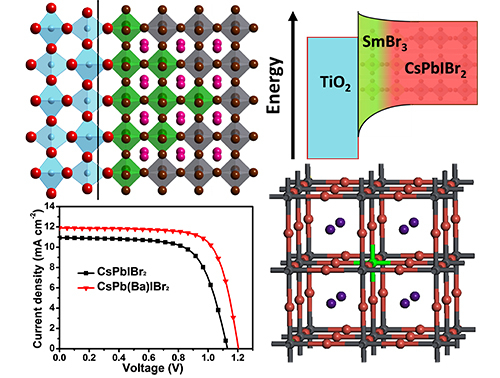
A research group led by Prof. LIU Shengzhong from the Dalian Institute of Chemical Physics (DICP) of the Chinese Academy of Sciences improved the photovoltaic performance of inorganic perovskite solar cells (PSCs). Their findings were published in Advanced Energy Material and Nano Energy.

Schematic diagrams of SmBr3 modification at TiO2/CsPbIBr2 interface and Ba2+ doping in CsPbIBr2. (Image by WANG Kai and DUAN Lianjie)
Organic-inorganic metal halide perovskite solar cells have attracted extensive attentions due to their high power conversion efficiency (PCE). However, the perovskites usually exhibit poor stability due to the weak interaction between organic cations and iodine-lead octahedrons, which restricts its further development for commercialization.
In contrast, all-inorganic perovskite materials (CsPbX3, X=I, Br) have become an emerging research subject due to their excellent thermal stability. However, due to the non-radiative recombination in PSCs based on inorganic perovskites, the photovoltaic performance still has a large room to improve.
In order to improve the PCE of inorganic PSCs, Prof. LIU adopted different strategies to suppress the non-radiative charge recombination in PSCs. In general, the non-radiative recombination in PSCs could be divided into two parts: interface recombination and non-radiative recombination in the perovskite layers.
For interface recombination, the researchers modified the electron transport layer/perovskite interface by using a lanthanide bromide and obtaining a gradient band structure at the interface, which inhibited the interface electron recombination successfully and enhanced the charge extraction as well. With this strategy, the PCE of CsPbIBr2-based PSCs was increased to 10.88%, representing a high level in this field.
In addition, barium ions were doped in CsPbIBr2 to suppress the inside non-radiative recombination. Although the radius of Ba2+ did not meet the requirements of the Goldschmidt rule, it could still optimize the optoelectronic properties of CsPbIBr2 and improved device stability.
This study showed that perovskite materials possessed a high tolerance to extrinsic metal ions. The above results provided a basis for the regulation strategy of inorganic perovskite and promoted the development of inorganic PSCs to a certain extent.

86-10-68597521 (day)
86-10-68597289 (night)

86-10-68511095 (day)
86-10-68512458 (night)

cas_en@cas.cn

52 Sanlihe Rd., Xicheng District,
Beijing, China (100864)

